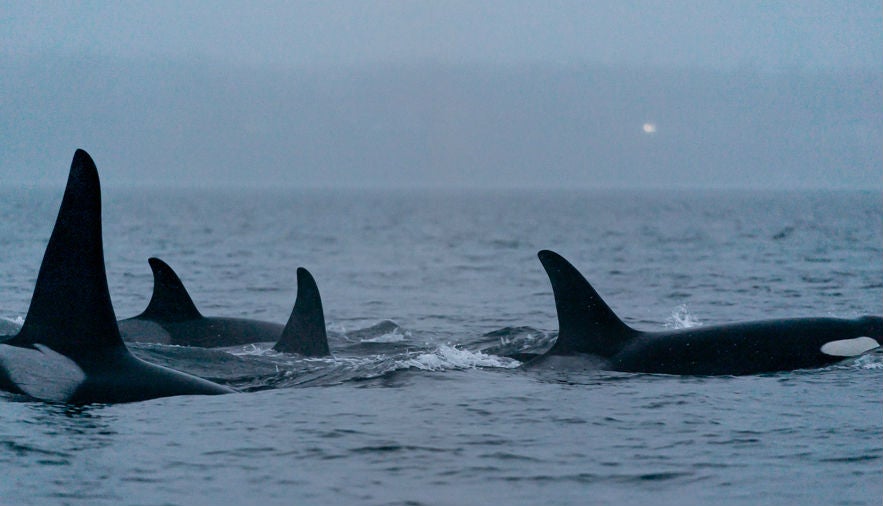Pleas for killer whales to have more space after spate of harassments
Fewer than 75 of this rare eco-type remain, writes Andrew Buncombe, and activists are battling to to save them

Wildlife campaigners in the Pacific Northwest have made an impassioned plea to boaters to steer clear of the region’s endangered killer whales, following a spate of “harassments” by boat owners and enthusiasts.
As the whales move further south this autumn to feed on coho and chum salmon, bringing them closer to marinas and docks in an around the port of Seattle, activists fear opportunities for people to get too close to the creatures will increase.
They are especially concerned because of the presence among the whales of two new calves and two pregnant mothers.
“We’ve got a baby boomlet,” Howard Garrett, who with this wife, Susan Berta, runs the Orca Network, told The Independent. “And we’re asking people to give them some space.”
The Puget Sound and the surrounding waters are home to two distinct eco-types of killer whales. The Bigg’s killer whales, or “transients”, feed on seals, porpoise and other marine mammals. While these whales are listed as “threatened” by Canada, in the US they are not, and experts say their population is doing well.
The second group are the “residents”, which number fewer than 75 and which are listed as “endangered”. They feed almost entirely on salmon with the high-fat chinook, its preferred food.
Experts say the whales involved in a series of incidents this summer in which boats got too close to the mammals, and in some cases even chased them, were the more common transients, which confusingly can also be spotted here all year round.
Activists are deeply concerned that as the endangered resident whales move south to inland waters to feed, they too could come into contact with boats.
Their concerns are heightened by two factors. One is that as the coronavirus pandemic has dragged on, the region has seen a leap in boat sales of as much as 30 per cent.
The second is the presence among the residents of two pregnant mothers and two calves. One of the new babies was born to a whale known as J35, or Tahlequah.
Two years ago that animal brought the plight of the whales to the eyes of the world, when she carried a dead calf she had given birth to over the course of 1,000 miles for 17 days, an event some interpreted as a mourning journey.
“Fall is the season Puget Sound orca lovers have been waiting for, signalling the return of southern resident orcas to our urban inland waters, creating many opportunities for amazing shore-based encounters with our favourite pods as they swim past our neighbourhoods following salmon,” Ms Berta said in a statement.
“This is also an important time for boaters in our urban waterways to be aware of the presence of whales, and to give the Southern Resident orcas plenty of space - especially with the birth of little J57 and J58, the newest members to this endangered community of orcas.”
The group has begun a “Share the Water” boater education programme, to complement the "Be Whale Wise“ scheme in which Orca Network and other organisations are working with the federal National Marine Fisheries Service (NOAA) to inform the public. It says education is required to change people’s behaviour, along with enforcement state and federal enforcement.
State and federal regulations call on boats to stay at least 300 yards from the southern resident orcas, or 400 yards ahead and behind their direction of travel. Vessels must also stay below seven knots within a half-mile. If a whale gets closer, the captain must turn off their boat’s engine.
Officials said the worst offenders are not commercial whale watching outfits, which are important to the local economy, but owners or renters of private vessels, who either do not care about the rules, or else do not know them.
Cpt Alan Myers, who heads Washington’s state department of fish and wildlife’s enforcement team, said while his modestly-sized team had a vast swathe of ocean to cover, they took every reported violation seriously.
“There are only 74 or 75 of these animals left on the planet. And it's imperative that we take care of the violation reports seriously,” he said.
Activist Amy Bliss Miller lives in Gig Harbor, close to Vashon Island, on the inland waters of the southern Puget Sounds. This summer she and other members of the Salish Wildlife Watch witnessed numerous instances of boats getting too close to various Bigg’s killer whales.
They posted video of the incidents on their Facebook page, in an attempt to shame people to obey the rules. One post received more than 21,000 views.
In her opinion, given the threat faced by the southern residents, people ought not to be permitted to watch them from the water. But she said a ban was unlikely given the commercial whale watching industry’s powerful lobby.
She said very often, it was easier to be closer to the whales from certain locations on land.
At the same time, if people are intent on watching them from the ocean they must give the whales plenty of space.
“I understand the excitement, I really do. I’ve been kayaking in the water when they are there in the distance, and they are amazing,” she said.
“But there are more respectful ways to watch them. If people people really care, they should let them be.”
Subscribe to Independent Premium to bookmark this article
Want to bookmark your favourite articles and stories to read or reference later? Start your Independent Premium subscription today.

Join our commenting forum
Join thought-provoking conversations, follow other Independent readers and see their replies